Part of a series of articles titled Preservation Matters.
Article
Preservation Matters: Landscape Maintenance - Protecting Historic Trees During Construction
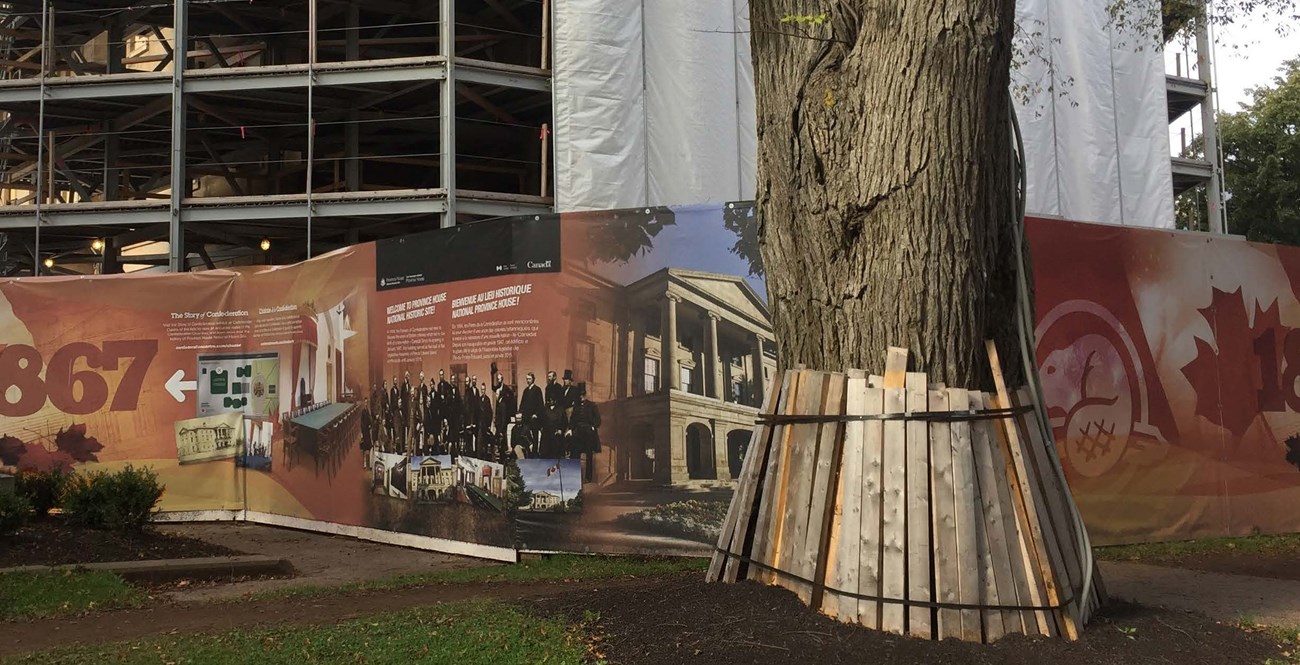
CPepper 2018
Historic trees are valued as living witnesses to earlier times, events, and stories at historic properties. They are often cherished and appreciated for their stature in the landscape and how their majestic qualities contribute to conveying the history of a site. Such old trees, however, are vulnerable to impacts from site use and construction, such as soil compaction and physical damage to roots, trunk, and limbs. These impacts can cause trees to decline in health and possibly lead to their demise. As trees age they become less able to recover from impacts associated with construction and are more likely to prematurely deteriorate. Protecting historic trees from damage during construction can be accomplished effectively with an understanding of potential construction impacts and implementing relatively simple and effective protection options.
TYPES OF CONSTRUCTION DAMAGE
Trees in the vicinity of a construction site can sustain damage from soil compaction, severing of roots, trunk and limb injury, and limb breakage from construction equipment and activities.
Trees are alive and like most living things they need access to water, air, sunlight, and nutrients to maintain good health. Trees also need structural stability and relatively intact wood in order to support themselves and to prevent breaking limbs or the entire tree falling over. In a landscape where trees have access to adequate resources such as high-quality soil, nutrients, light, and water, they can grow effectively and can sufficiently sustain themselves. However, adverse impacts from unmitigated on-site construction can undermine a tree’s stability by impairing soil quality, limiting access to light and water, or by causing physical damage to roots, trunks, and branches. Some specific types of tree damage that can occur during site construction include:
- Soil compaction – Heavy equipment, storage of supplies and materials, and work activities within or near a tree’s dripline (i.e. directly below the canopy) can cause the soil within the root zone to compress and can often limit the availability of air, water, and nutrients to the roots. Soil compaction is greatly increased following an event such as rain or irrigation, when wet or moist soil is compressed by equipment or foot traffic. Compacted soil is extremely difficult to remedy and can lead to the decline and/or death of a tree.
- Severing of roots - Construction projects may require the installation or the rehabilitation of footings, foundations, paved areas, walkways, roads, irrigation lines, drainage systems, utilities, etc. When such construction occurs adjacent to trees, roots are often severed to facilitate the work. Roots principally serve three functions for a tree: they provide structural stability to keep the tree upright and anchored to the soil, they absorb water and nutrients from the soil, and they are a storehouse of nutrition that supports tree growth and development. When roots, especially those over two inches in diameter, are severed during construction, trees can become less stable, absorb less water and nutrients, and lose stored nutrition, all of which can lead to decline and/or death.
- Trunk and limb injury – Gashes and cuts in tree trunks can occur from accidental vehicle and equipment hits, strikes from materials such as lumber or steel beams, hand and power tools, etc. Such impacts open wounds by breaching the tree’s protective layer of bark and exposing it to damaging insects and plant diseases. The physical damage that is caused can also disrupt the effective flow of water and nutrients through the trunk and limbs to other parts of the tree. Depending on the severity of the impact and the damage caused, trunk and limb injury can cause tree decline and possible death.
- Limb breakage – Trucks and other large equipment that strike tree limbs can cause breakage. The loss of limbs through breakage results in two principle impacts to trees: reduced capacity to capture sunlight for photosynthesis through lost foliage, and the opening of branch wounds that expose the tree to damaging insects and diseases. While the loss of smaller limbs and branches may only cause a minimal set-back in the health and vitality of a tree, breakage and/or loss of particularly large limbs can result in tree decline and death.
PREEMPTIVE PROTECTIVE MEASURES
Collect and propagate cuttings of historically significant trees before construction begins.
Historically important trees that have significant associations with people, events, design, etc., or are irreplaceable through commercial nursery sources, should be preserved by collecting and propagating cuttings prior to the start of construction. While such cuttings may not be needed to replace the original tree due to decline resulting from construction damage, it is better to have these available if needed. Rooting cuttings from aged trees may require specialized facilities and skills. Consult with a local plant nursery about propagation services they may be able to provide.
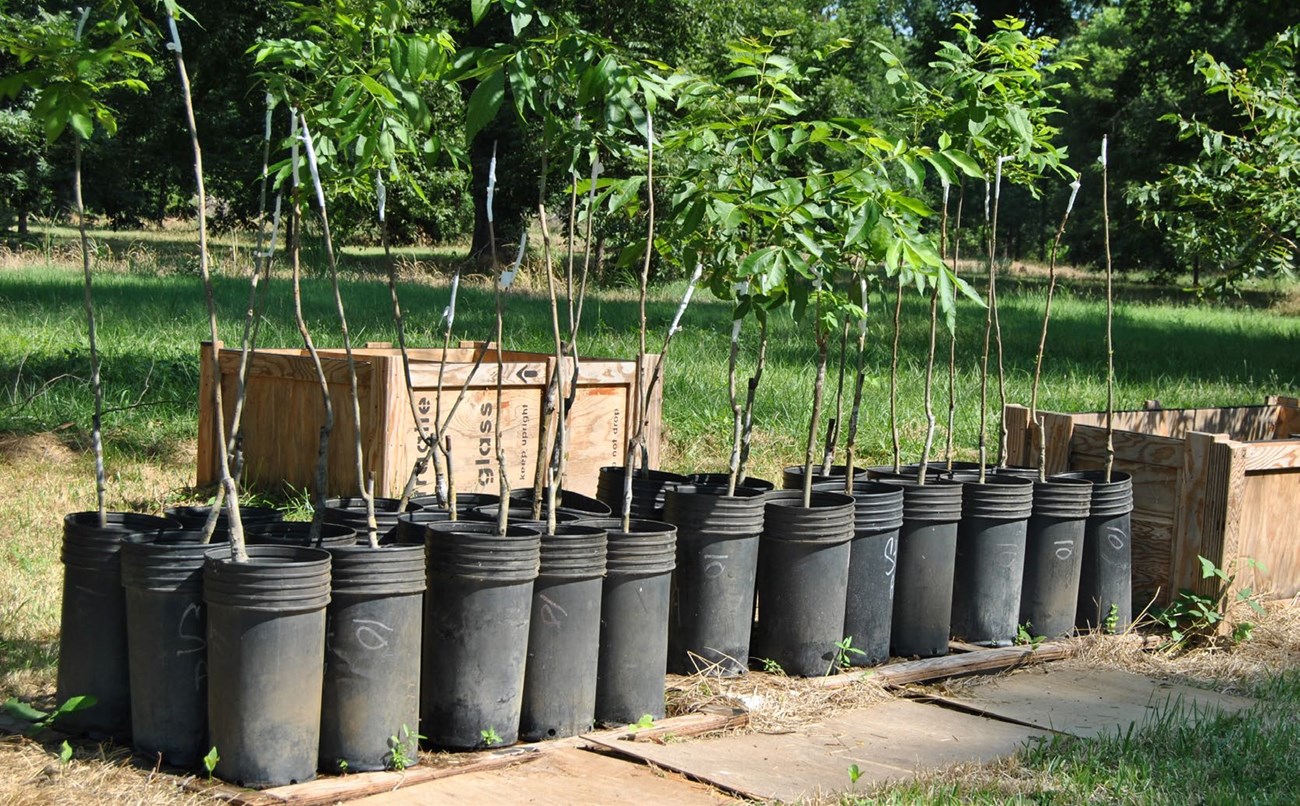
NCPTT 2012
SENSITIVE CONSTRUCTION TECHNIQUES
Plan to use sensitive construction and site-work techniques in the vicinity of protected trees.
- Survey the construction site and identify all trees that need protection.
- Make a comprehensive plan to avoid soil compaction and to protect tree roots, trunk, and limbs as discussed here, modifying construction techniques where necessary to minimize tree damage.
- Use the smallest equipment possible or accomplish tasks by hand where feasible.
- If excavation is needed, use soil-boring equipment that tunnels well under a tree’s root system rather than using a backhoe or other trenching equipment.
AVOIDING SOIL COMPACTION
Avoid soil compaction within the tree’s dripline during the construction process.
- Minimize the use of heavy equipment, storage of supplies and materials, and work activities within or near a tree’s dripline (i.e., directly below the canopy).
- If the scope of the project must include work and/or access within the tree’s drip line or near the trunk, apply interlocking heavy equipment mats, ¾” plywood, 6 inches of organic mulch, and/or other materials that help to absorb and distribute the weight of equipment, foot traffic, or storage of materials in order to prevent soil compaction.
- If possible, aerate the soil with lawn core-aerator equipment before, during, and after construction activities and backfill aeration holes with composted organic material to aid in mitigating the impacts of compaction.
- Take special care to minimize construction equipment or foot traffic near protected trees following a rain event or irrigation, when soil is vulnerable to compaction.
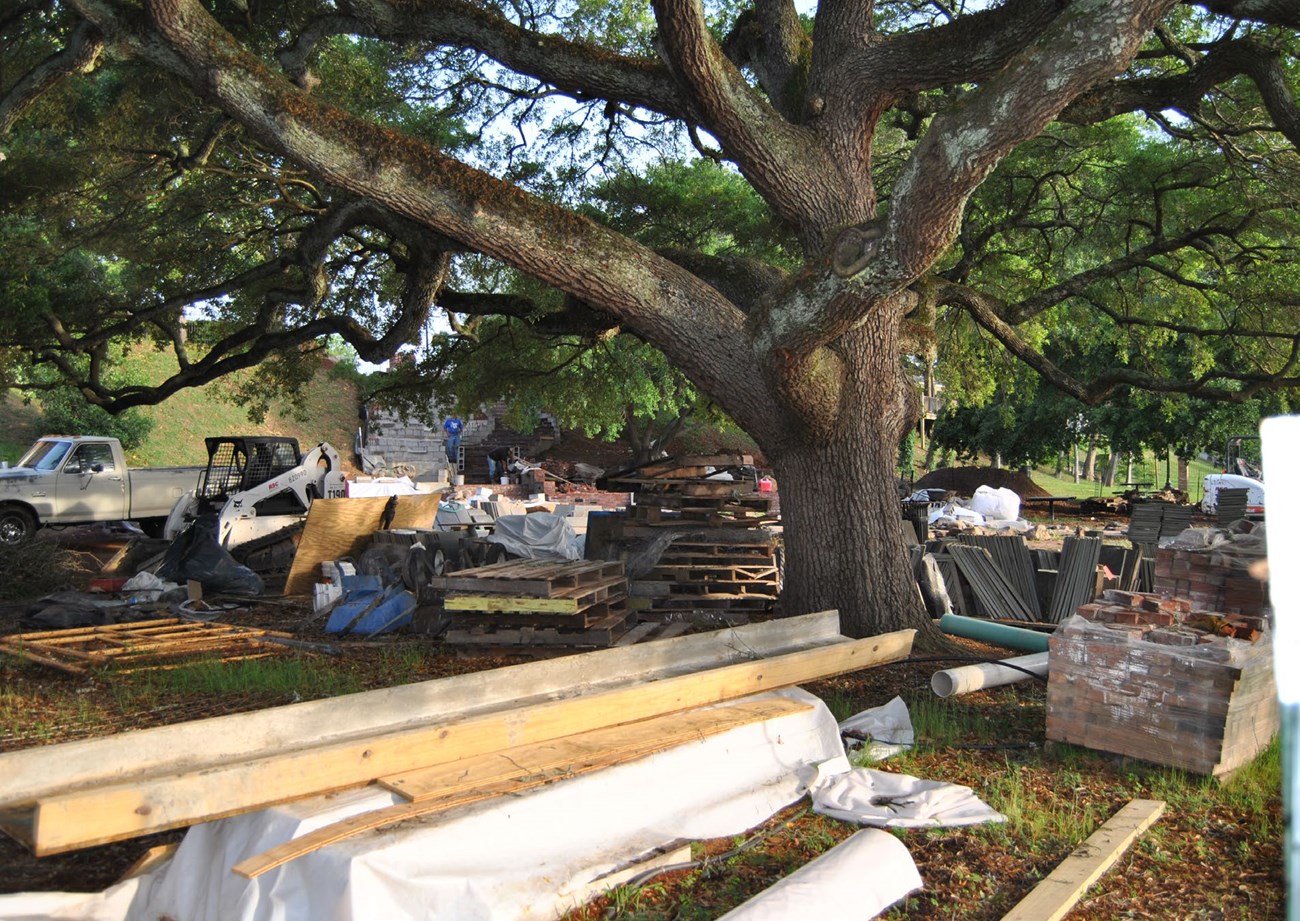
NCPTT 2009
PROTECTING TREE ROOTS
Protect tree roots from physical damage during the entire construction project.
Create a “Tree Protection Zone” around each historic tree to minimize access to the area and prevent the area from being excavated, used to stockpile material, dump debris, or for equipment access/storage. Clearly define the boundaries of the Tree Protection Zone by installing a temporary fence around the zone. Ideally the fence should be installed at a distance of 1½ times the diameter of the edge of the outermost leaves (also known as the “canopy dripline”). For example, if the diameter of the tree (from outermost leaves on one side to the outermost leaves on the opposite side) is 60 feet, the fence should be placed completely around the tree at 45 feet away from the trunk for a total diameter of 90 feet (1½ x 60 feet). At a minimum, place the fencing at the edge of the canopy dripline (60 feet in this example).
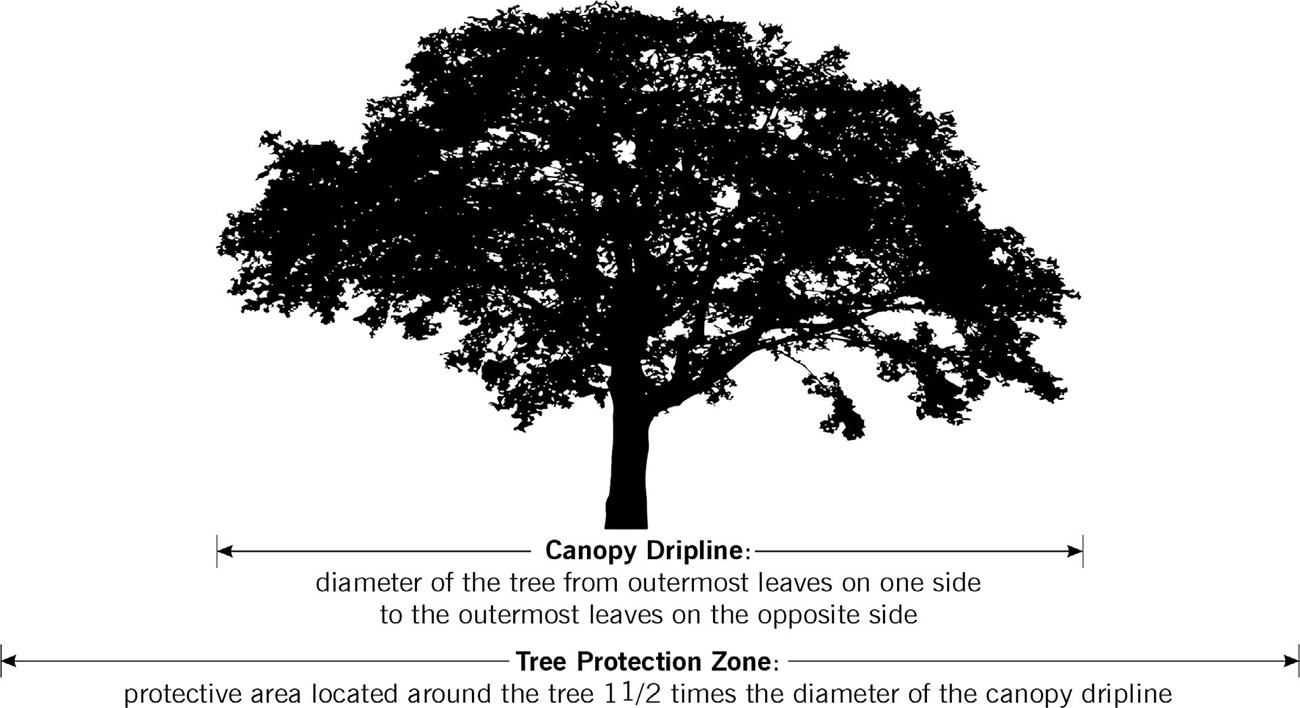
- If soil excavation is within the Tree Protection Zone adjacent to an aged tree, try to clear around larger roots by hand and leave as many of them as intact as possible. Ideally, use an Air-Spade™ or similar equipment to remove soil from around the roots, as an alternative to excavating with powered equipment or hand digging. If roots must be exposed to the air, they should be kept moist by installing and using a temporary irrigation or mist system while site construction is underway and until the exposed roots can be recovered with soil.
- While it is best not to alter the soil grade within the tree’s dripline, it is sometimes necessary for construction. If necessary, keep the depth of changes to a maximum of three inches. Significant changes in soil grade can affect the fine root system that exists within the top 6-12 inches below grade. Added soil can inhibit roots from “breathing” by smothering them and essentially suffocating the root system.
PROTECTING TRUNK AND LIMBS
Protect tree trunks and limbs from physical damage from construction equipment.
- Protect tree trunks from mechanical damage prior to construction. If a tree trunk is close to the construction work or staging area, wrap the entire trunk with 2x4 lumber or other protective material. Place 2x4’s vertically, side by side, around the diameter of the tree trunk and hold securely in place with strapping. This will protect the trunk from potential physical damage from vehicles, equipment, hand tools, or debris being used in the project area.
- Prior to construction, pull and tie back limbs that may impede the construction zone. Minimize pruning or removing limbs; even large limbs over 3” in diameter may have the flexibility to be effectively pulled and tied away from the work area.
- Properly prune branches or roots that are broken and/or damaged during construction. Any limbs or roots that are damaged during the work should be removed with a clean saw cut at an adjoining limb or branch using good pruning techniques.
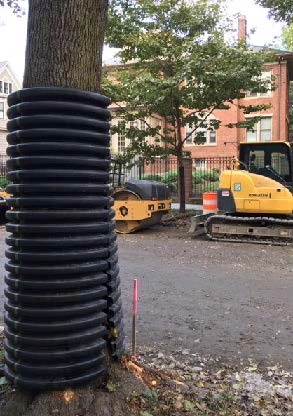
CPepper 2018
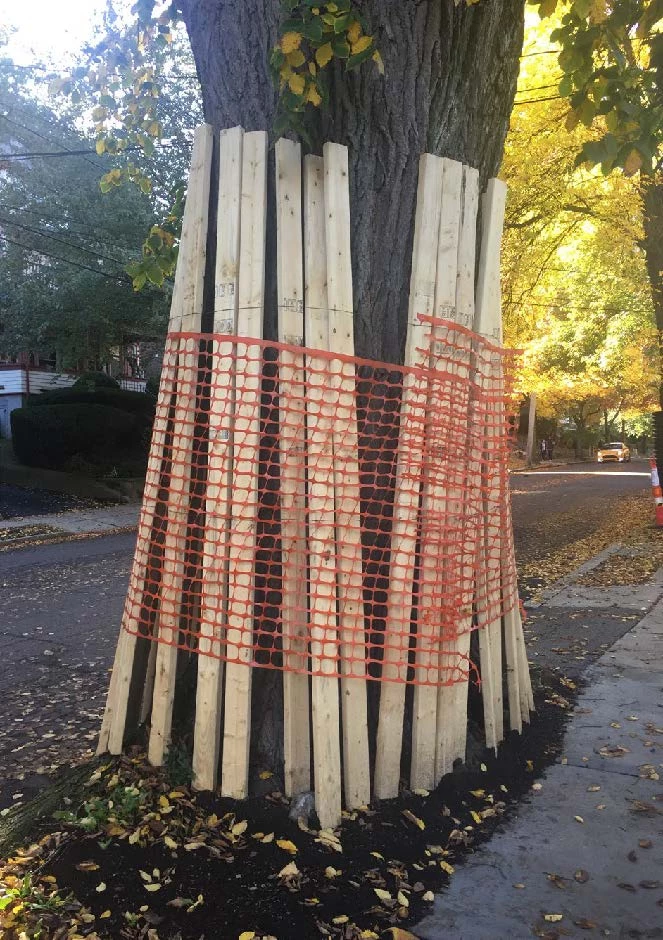
CPepper 2018
MONITORING TREES POST-CONSTRUCTION
Tree condition in post-construction zones should be monitored regularly for signs of damage.
Construction impacts to trees are often not readily visible and can manifest over months or even several years. It may be three, five, or more years before a tree shows symptoms and decline from construction impacts. Tree condition in post-construction zones should be monitored regularly each year. A professional certified arborist should be consulted if any indications of deterioration appear (yellowing of leaves on multiple limbs, dieback, leaning, dropping of limbs, mushroom or fungi growth on roots, trunk or limbs, etc.).
Case study of construction damage on a magnolia tree.
This series of photographs shows how repeated tree damage manifested in the years and months following construction projects adjacent to a mature magnolia tree.
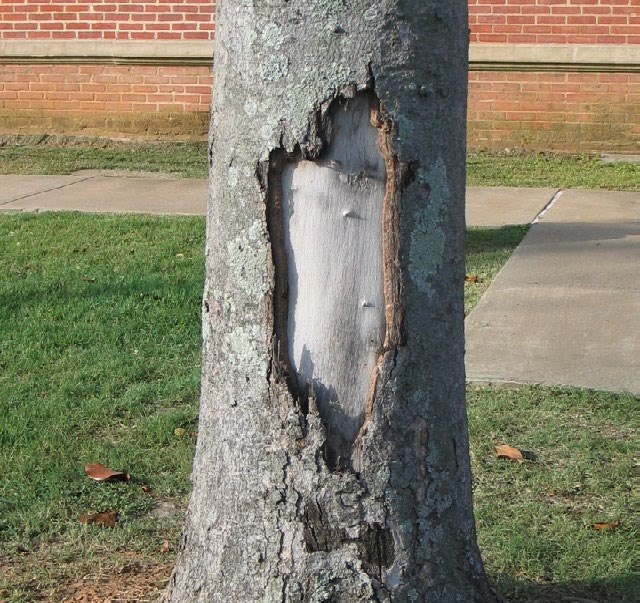
1. Heavy equipment during a 2000 renovation of a nearby building damaged the trunk of the tree. The resulting bark damage was photo documented several years later. (NCPTT June 2007)
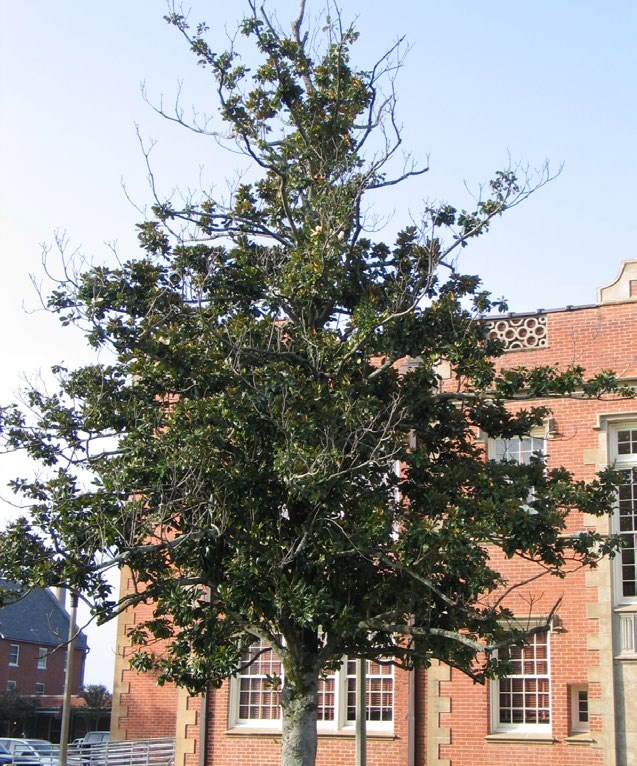
2. In 2007, dead limbs caused by the damaged bark were evident in the tree canopy. (NCPTT June 2007)
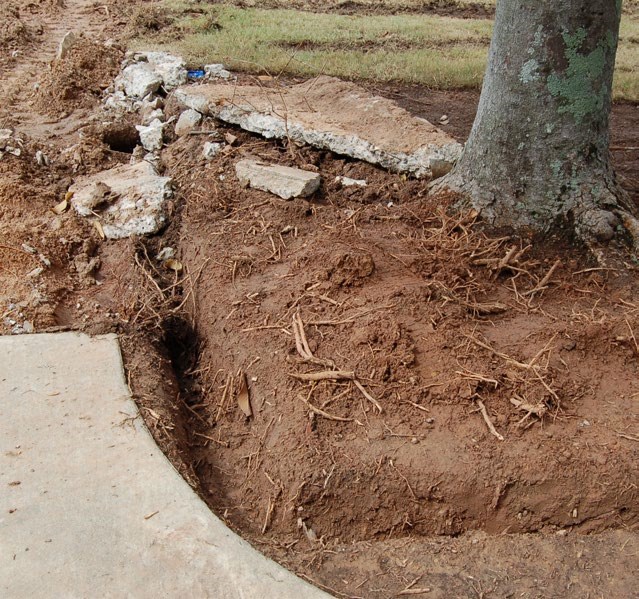
3. The same year, trenching to install an irrigation system severed major roots within several feet of the magnolia tree trunk. (NCPTT July 2007)
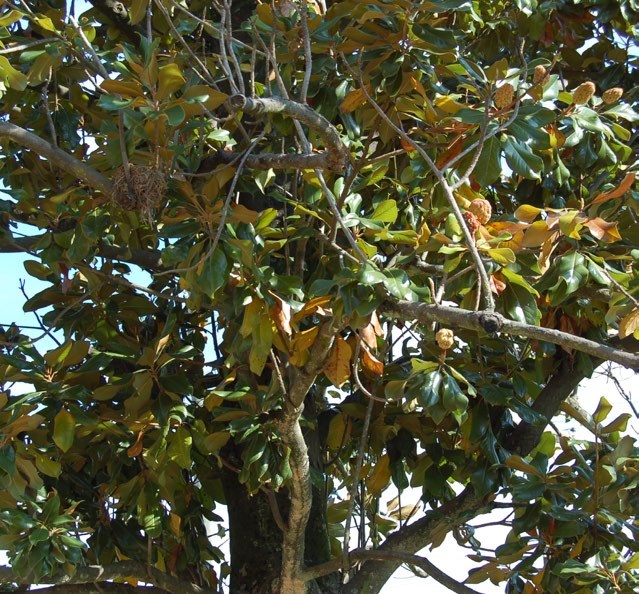
4. At one month post-trenching, wilting and drying leaves were found in the canopy. (NCPTT August 2007)
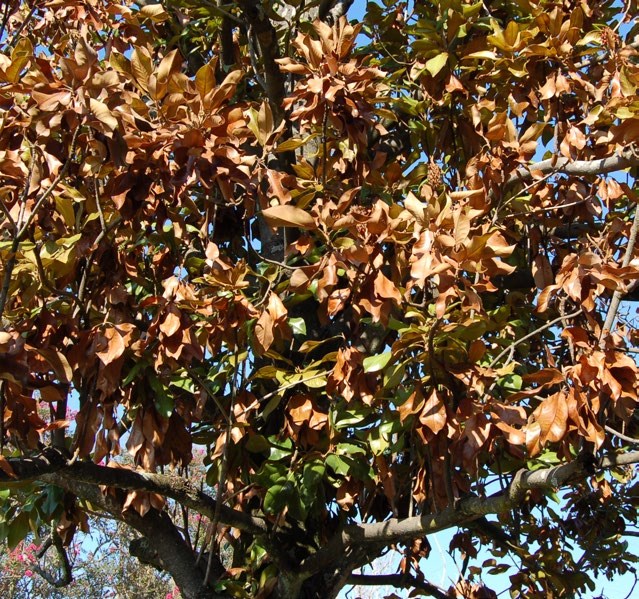
5. At two months post-trenching, substantial dieback was evident. The tree continued to decline, and removal was necessary several months later. (NCPTT September 2007).
REFERENCES
Avoiding Tree Damage During Construction. https://www.treesaregood.org/portals/0/ docs/treecare/AvoidingTreeDamage.pdf
Preventing construction damage to trees and shrubs. https://www.mortonarb.org/ trees-plants/tree-and-plant-advice/horticulture- care/preventing-construction-damage- trees-and-shrubs
How to Protect Trees During Underground Work. https://www.arborday.org/trees/bulletins/ documents/035-summary.pdf
Treatment of Trees Damaged by Construction. https://www.treesaregood.org/portals/ 0/docs/treecare/constructiondamage.pdf
Pruning Mature Trees. https://www.treesaregood. org/portals/0/docs/treecare/pruning_ maturetrees.pdf
Mature Tree Care. https://www.treesaregood. org/portals/0/docs/treecare/mature_ treecare.pdf
Caring for Trees in Historic Landscapes. https://www.mass.gov/doc/terra-firma-2- caring-for-mature-trees-in-historic-landscapes- 0/download
ABOUT NCPTT
The National Center for Preservation Technology and Training (NCPTT) is the principal research, technology, and training center within the National Park Service.
NCPTT helps preservationists find better tools, better materials, and better approaches to conserving historic buildings and landscapes, archaeological sites, and museum collections. It conducts research and testing in its laboratories, provides cutting edge training around the U.S., and supports research and training projects at universities and nonprofits. NCPTT pushes the envelope of current preservation practice by exploring advances in science and technology in other fields and applying them to issues in cultural resource management.
NCPTT publishes its Preservation Matters Series to provide easily accessible guidelines for preserving cultural materials.
National Center for Preservation Technology and Training
645 University Parkway
Natchitoches, LA 71457
Website: www.nps.gov/ncptt
Phone: (318)356-7444
CREDITS
Author: Charlie Pepper, Principal, Landscape Preservation Specialists
Series Editor: Kirk A. Cordell, NCPTT Executive Director
Last updated: September 29, 2022
